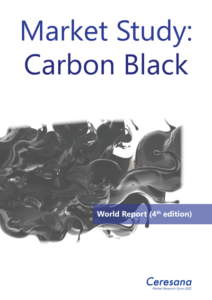Carbon black market demand to reach 17 million tons per year
Konstanz, Germany – The most recent Ceresana report concerning the world market for carbon black shows that this important industrial base material is still mainly produced by incomplete combustion of fossil raw materials, most often from heavy petroleum fractions. The current market report predicts that the demand for carbon black will rise to 17 million tons per year by 2030.
Carbon black is being used as a filler and reinforcing agent in tires and many other rubber products. An average car tire contains around 3 kg of carbon black. Accordingly, the segment tires, including tires made from the rubber types SBR, BR or natural rubber, constitutes by far the most important application area: currently, the worldwide demand for carbon black in this segment amounts to 8,5 million tons per year. Elastomers for industrial applications comes in second place: Carbon black is needed for a variety of rubber products in different industries, from the chemical industry, mechanical engineering and the construction industry, to the electrical and electronics industry. It is used, for example, in the production of conveyor belts, roll covers, hoses, profiles, seals, cables, molded parts, and roofing foils. The use of carbon black as a black pigment accounts for only a comparatively small share of the total market. In this application area, it is utilized in plastics, paints and coatings as well as printing inks. In a technical sense, even small amounts of carbon black can be significant, as it can be used, e.g., for UV-protection in high-performance coatings or as ESD-protection.
The global production of and demand for carbon black are increasing. The region Asia Pacific is a forerunner in this area: It accounts for more than 64% of the global carbon black production volume. With a demand of approx. 4.8 million tons, China is the largest consumer of carbon black. Especially due to the growing domestic demand in China, but also in India, Asia-Pacific will continue to increase the production of carbon black – to probably more than 11.8 million tons in the year 2030. North America takes up a distant second place compared to Asia-Pacific, closely followed by Eastern Europe. In regards to demand for carbon black, North America is also in second place, and Western Europe in third place. Compared to the more common virgin carbon black (vCB), recovered carbon black does not play a big role: less than 1 percent of the carbon black used in new tires is recycled. The available amounts and standardization of quality are not yet sufficient for wider use. However, there is at least one standard already in existence: ASTM D8178 regulates the terminology concerning recovered carbon black.

